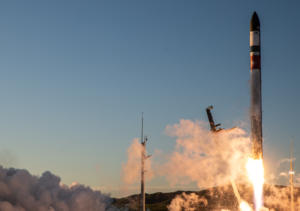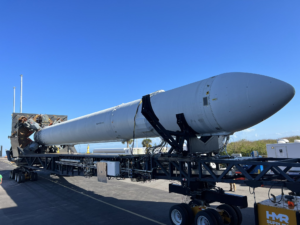
How Does Blue Origin Plan To Land New Glenn’s Booster?
Blue Origin has been working on New Glenn for quite a while now. While updates on the rocket are rare, we have learned about a host of changes to either the rocket itself or its mission profile, that are different from the original plan. Its not uncommon that while companies are developing rockets, things change throughout this process. However, Blue Origin and New Glenn have been making some significant updates to the future of New Glenn.
Since New Glenn was practically announced, the plan has been for the first stage to be reusable. Specifically, Blue Origin wanted to land this 60 meter tall booster on a moving ship out at sea. The company even purchased a cargo ship and worked to refit it as a mobile landing platform in the ocean for future New Glenn launches. This being said, recently the company scrapped the ship which brings up the question, what is Blue Origin’s plan going forward?
We have seen SpaceX land Falcon 9’s booster many times on drone ships at sea, but this is by no means an easy process. Not to mention the significant size difference between a Falcon 9 booster and New Glenn’s booster. Here I will go more in-depth into the ship being scrapped, possible plans going forward, how the booster is expected to land, and more.
Landing Ship Scrapped

To get a better idea of what Blue Origin’s original goal was, we can take a closer look at the mission profile. For a nominal 250 km perigee altitude GTO mission, the first stage booster initiates an engine shutdown sequence at a mission elapsed time (MET) of 199 seconds. The command induces the BE-4 main engine cut-off (MECO), and thrust tails off until second stage separation occurs at MET 202 seconds. The first stage then reorients for atmospheric reentry, landing, and recovery on an ocean platform.
In addition to this, through various animations and plans, Blue Origin has shown off a converted ship as the future landing platform for New Glenn’s booster. Back in 2018, Blue Origin purchased the Stena Freighter, a 183 meter long cargo ship with the intention of transitioning it into a future landing platform. During 2018 to 2022, the ship had been in port undergoing refit to prepare for the role of landing launch vehicle first stages. Initially, boosters were planned to be recovered downrange of the Cape Canaveral Launch Complex 36 (LC-36) in the Atlantic Ocean while the hydrodynamically-stabilized ship was underway. The ship stabilization technology was intended to increase the likelihood of successful rocket recovery in rough seas, as well as helping to carry out launches on schedule.
However, just a few months prior, Blue Origin abandoned their plans to use the ship as a landing platform, and in August 2022, the ship was towed to the Port of Brownsville for scrapping. With this being the case, it means Blue Origin needs a different plan to land New Glenn’s booster out at sea. One of the first options that comes to mind is a large barge like SpaceX. This being said, there is quite a significant difference in size between New Glenn and Falcon 9. To put the size in perspective, SpaceX operates multiple landing barges, Just Read The Instructions for example is 170ft by 300ft or 52 meters by 91 meters. This already is practically the size of a football field, yet with the Falcon 9’s booster legs out for landing, it doesn’t have much room at all for error. The Falcon 9 booster has a diameter of 3.7 meters and a height of just over 40 meters. New Glenn’s booster on the other hand is around 60 meters tall and almost double the diameter of the Falcon 9 with a 7 meter width. Combine this with its six hydraulically actuated legs that support and secure the first stage, and you would need a massive barge. While quite the endeavor, Blue Origin could make some ambitious goals come to life with the future of New Glenn booster reusuablity, it will just be very difficult.
New Glenn’s Booster

Now that we know more about New Glenn’s landing options and what happened to the company’s ship, we can take a closer look at the booster and how it’s expected to land. First, at the very top of the booster are fins. Specifically, the four forward fins are actuated aerodynamic control surfaces used for attitude adjustment during the descent and landing of the first stage. Toward the bottom of the booster are two wing like surfaces. Here two strakes provide lift and cross-range for the reusable first stage as it flies back to Earth. Ideally, after second stage separation, the first stage booster reorients itself to reenter the atmosphere aft end first. Through a combination of aerodynamics and propulsive maneuvers, the stage performs a precision landing on the ocean-going platform in the Atlantic Ocean.
In order to achieve this landing, the booster’s engines would need to slow down the rocket quite a bit. With seven reusable and throttleable BE-4 LOX/LNG engines, the first stage generates 17,100 kN (3.85 million lbf) thrust at sea level. BE-4 was designed from the beginning to be a medium-performing version of a high-performance architecture. It’s a conscious design choice made to lower development risk while meeting performance, schedule and reusability requirements. The overall goal from Blue Origin is to reuse this booster at least 25 times. This means the engines also need to be capable of launching again with limited matinance in between.
Going more in-depth into the booster, the New Glenn first stage is operationally reusable with a length of 57.5 m (188.5 ft) and a tank diameter of 7 m (23 ft). The stage consists of three (3) sections: aft, mid, and forward. The aft module of the booster contains seven BE-4 engines. The restartable BE-4 engines provide precision thrust vector control and continuous deep throttle capability to support propulsive deceleration and landing maneuvers, while featuring long design life. The 8.5 m (28 ft) diameter engine skirt protects the engines from atmospheric reentry conditions and contains six stowed landing gear. The mid module of the booster houses the fuel (LNG) and oxidizer (LOX) tanks. The tanks are made of orthogrid aluminum and are designed to withstand the high g-loads realized during reentry. Large aerodynamic strakes on the aft end of the tanks give the returning first stage enhanced cross-range during descent and reentry. The forward module of the booster features four actuated aerodynamic control fins for attitude control during descent. This section of the booster also provides ground umbilical connections for New Glenn and interstage housing of the two second stage vacuum-optimized BE-3U engines. The forward module houses various guidance navigation & control avionics, including an autonomous flight safety system. The pneumatic pusher stage separation system, which provides positive separation before second stage ignition, is located in the forward module. Meant to all work together and help land this booster downrange.
As for the upper stage, this is an expendable LOX/LH2 stage with dual gimballing BE-3U engines with 1,060 kN (240,000 lbf) total thrust in vacuum. The stage also has a tank diameter of 7 m (23 ft) and uses common tooling with the first stage to reduce recurring cost. The length of the second stage tank is 16.1 m (52.9 ft) and the overall length including the two high expansion ratio nozzle BE-3Us is 23.4 m (76.9 ft). Similar to the first stage, the second stage has aft, mid, and forward sections. The aft section consists primarily of the two BE-3U engines, associated load bearing cross-bar thrust structure, and tankage/equipment for long duration operations. The reaction control system (RCS)/settling system uses tri-axial thrusters distributed in four places along the thrust structure. The second stage aft section integrates with the first stage forward section and provides one of two (2) second stage umbilical interfaces.
The mid-section contains all propellant tankage including a forward LH2 tank and an aft LOX tank, separated by a common insulated bulkhead. The tank barrels are orthogrid aluminum construction, and the domes are constructed from welded aluminum. A single external insulated LH2 supply line passes around the LOX tank. Not very long ago we learned about project Jarivs and the possibility of this stage becoming reusable as well rather than its current expendable design. While very difficult, this would provide some additional benefits in the form of launch cadence and cost if successful. However, it also makes it clear that Blue Origin is not exactly sure what the future of New Glenn looks like. In reality, it will likely be a few years before we see the first test flight of this rocket. For upper stage resutiblyt, it’s possible at first Blue Origin uses an expendable option and later down the line switches to reusable.
Conclusion
Blue Origin has been developing New Glenn for quite a few years now. During this time they have made some progress on the engines and built a frame of the rocket. In addtion they have changed their minds a few times regarding different aspects such as whether or not the upper stage will be reusable, along with what the landing platform for the booster will look like. With the original ship planned to support the booster landing now scrapped, we will likely see work on a droneship like SpaceX’s. We will have to wait and see how it progresses and the impact it has on the space industry.



